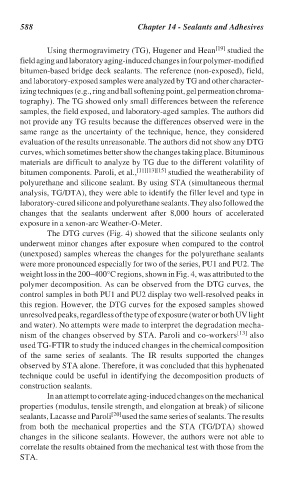Page 620 - Handbook of Thermal Analysis of Construction Materials
P. 620
588 Chapter 14 - Sealants and Adhesives
Using thermogravimetry (TG), Hugener and Hean [19] studied the
field aging and laboratory aging-induced changes in four polymer-modified
bitumen-based bridge deck sealants. The reference (non-exposed), field,
and laboratory-exposed samples were analyzed by TG and other character-
izing techniques (e.g., ring and ball softening point, gel permeation chroma-
tography). The TG showed only small differences between the reference
samples, the field exposed, and laboratory-aged samples. The authors did
not provide any TG results because the differences observed were in the
same range as the uncertainty of the technique, hence, they considered
evaluation of the results unreasonable. The authors did not show any DTG
curves, which sometimes better show the changes taking place. Bituminous
materials are difficult to analyze by TG due to the different volatility of
bitumen components. Paroli, et al., [11][13][15] studied the weatherability of
polyurethane and silicone sealant. By using STA (simultaneous thermal
analysis, TG/DTA), they were able to identify the filler level and type in
laboratory-cured silicone and polyurethane sealants. They also followed the
changes that the sealants underwent after 8,000 hours of accelerated
exposure in a xenon-arc Weather-O-Meter.
The DTG curves (Fig. 4) showed that the silicone sealants only
underwent minor changes after exposure when compared to the control
(unexposed) samples whereas the changes for the polyurethane sealants
were more pronounced especially for two of the series, PU1 and PU2. The
weight loss in the 200–400°C regions, shown in Fig. 4, was attributed to the
polymer decomposition. As can be observed from the DTG curves, the
control samples in both PU1 and PU2 display two well-resolved peaks in
this region. However, the DTG curves for the exposed samples showed
unresolved peaks, regardless of the type of exposure (water or both UV light
and water). No attempts were made to interpret the degradation mecha-
nism of the changes observed by STA. Paroli and co-workers [13] also
used TG-FTIR to study the induced changes in the chemical composition
of the same series of sealants. The IR results supported the changes
observed by STA alone. Therefore, it was concluded that this hyphenated
technique could be useful in identifying the decomposition products of
construction sealants.
In an attempt to correlate aging-induced changes on the mechanical
properties (modulus, tensile strength, and elongation at break) of silicone
sealants, Lacasse and Paroli [20] used the same series of sealants. The results
from both the mechanical properties and the STA (TG/DTA) showed
changes in the silicone sealants. However, the authors were not able to
correlate the results obtained from the mechanical test with those from the
STA.

